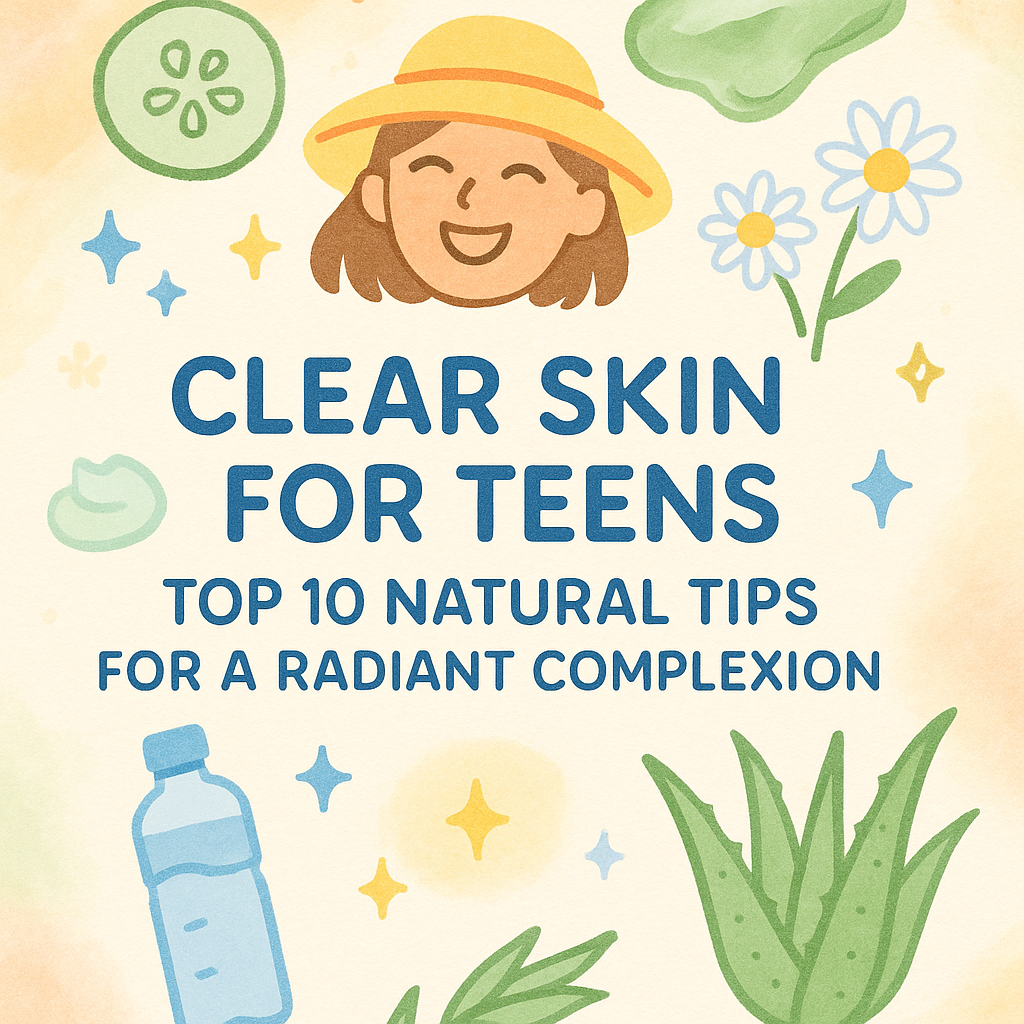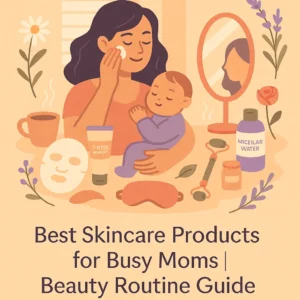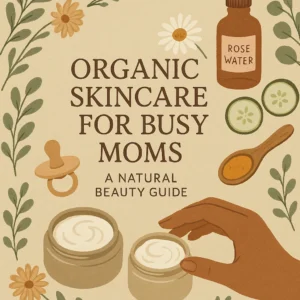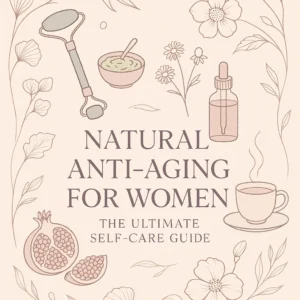Clear Skin for Teens: Top 10 Natural Tips for a Radiant Complexion
Achieving clear skin for teens is a common goal during adolescence. Puberty triggers hormone surges that stimulate oil glands, often clogging pores and causing acne. The good news is that many teens can improve their skin with simple, natural strategies. Dermatologists and skin experts emphasize a gentle, consistent routine and healthy habits. This guide provides the top 10 research-backed tips to help teenagers clear their complexion naturally. Each tip is designed to fit into a teen’s lifestyle and uses mostly natural, organic ingredients where possible.
1. Cleanse Gently, Twice a Day
A gentle cleansing routine is the foundation of clear skin for teens. Wash your face twice daily with lukewarm water and a mild, fragrance-free cleanser. Avoid harsh soaps or scrubs that strip the skin’s natural oils. As TeenVogue reports, washing your face once in the morning and once at night “will free your face of dead skin cells, bacteria and excess oil”. Likewise, medical sources advise using a soft circular motion with fingertips and rinsing well, but never scrubbing aggressively. Over-washing or rough scrubbing can damage the skin barrier and actually worsen acne. In short: cleanse gently, pat dry, and never more than twice a day.
2. Fight Acne with Gentle, Natural Ingredients
When choosing skincare products, look for proven, acne-fighting ingredients that are also gentle on young skin. Salicylic acid, a natural derivative of willow bark, is highly recommended; it unclogs pores and exfoliates the skin. Kiwi Spa notes, “Salicylic acid is a teen’s best friend when it comes to fighting breakouts”. Other beneficial natural actives include tea tree oil (a natural antibacterial), aloe vera (soothing anti-inflammatory), and even home remedies like a honey‑cinnamon mask. For example, applying a drop of tea tree oil directly on a pimple can help reduce bacteria, while aloe or green tea extracts can calm inflammation. In contrast, avoid overly harsh chemicals: teens should skip high-strength benzoyl peroxide or retinoids unless prescribed, since these can dry out and irritate sensitive skin. In summary, use gentle formulations with acne-fighting ingredients (salicylic acid, niacinamide) and natural extracts (tea tree, aloe) to clear teen skin.
3. Moisturize Properly (Even Oily Skin Needs It)
A common myth is that oily teen skin shouldn’t be moisturized. In reality, skipping moisturizer can trigger more oil production. After cleansing, apply a lightweight, non-comedogenic (won’t clog pores) moisturizer each day. Kiwi Spa emphasizes that “even oily or acne-prone skin” needs hydration. TeenVogue experts agree, noting that a light, oil-free lotion helps “lock in” the skin’s moisture without leaving a greasy film. This balances the skin so it doesn’t overcompensate by producing excess oil. Look for gel-based or oil-free moisturizers designed for sensitive or acne-prone skin. In short, hydrate to balance: moisturizing with the right product is essential for maintaining clear teen skin.
4. Apply Sunscreen Every Day
Sun protection is crucial for all skin types – including acne-prone teen skin. UV exposure can darken acne scars and worsen breakouts, so use a broad-spectrum sunscreen (SPF 30 or higher) daily. Choose a formula that is oil-free and non-comedogenic to avoid clogging pores. Dermatology experts advise a lotion or mineral sunscreen (zinc oxide or titanium dioxide) that won’t trigger acne. Even on cloudy days or under makeup, this extra layer protects skin. Remember, sunscreen is the last step in your morning routine to seal in moisture and shield skin. In brief: daily, non-greasy sunblock helps protect teen skin and keeps it clear.
5. Eat a Skin-Healthy Diet and Hydrate
What teens eat can impact their skin. Research suggests that a diet rich in low-glycemic foods – whole grains, fruits, vegetables, lean proteins – can improve acne and skin health. In contrast, high-sugar, high-fat “Western” foods (white bread, sweets, greasy snacks) may trigger hormone spikes that worsen acne. Healthline reports that a low-GI diet “may help with acne,” while also supplying essential nutrients. Teens should focus on whole foods: leafy greens, berries, yogurt (if tolerated), lean meats or beans, and plenty of water. Staying well-hydrated (8–10 glasses of water daily) also helps flush toxins and maintain moisture balance. Finally, certain vitamins and minerals – like zinc, vitamin A, C, and E – support clear skin. In sum, encourage a balanced diet and plenty of water: good nutrition can reduce breakouts and lead to a healthier complexion.
6. Get Enough Sleep and Manage Stress
Teen years are busy, but sleep is essential for skin repair. Aim for 8–10 hours of quality sleep every night. Lack of sleep and chronic stress can spike hormones (like cortisol) that exacerbate acne. Both dermatologists and spas note that “stress can trigger breakouts by increasing oil production”. Relaxation techniques – meditation, exercise, sports or even hobbies – can help keep stress hormones in check. Regular physical activity improves circulation and reduces stress, which benefits skin. In short: good sleep habits and stress relief are key parts of the clear-skin routine for teens.
7. Practice Good Hygiene Habits
Simple habits go a long way. Avoid touching or picking at your face – hands carry oil and bacteria that can worsen acne. Dermatologists strongly advise: “Do not touch or pick at problem areas,” since this spreads germs and causes inflammation. Also, keep things clean: wash pillowcases, phone screens, and makeup brushes regularly to prevent bacteria buildup. If wearing a face mask, use a fresh one daily (or wash it). Teens with oily hair should shampoo frequently, since oils can transfer to the skin. In essence, don’t recontaminate your skin – keep hands off your face and maintain clean surroundings to support clear skin.
8. Use Gentle, Non-Comedogenic Products
When choosing products, opt for those labeled non-comedogenic and fragrance-free. Avoid harsh ingredients and heavy cosmetics that can clog pores. For example, Mayo Clinic experts warn against abrasive scrubs or strong astringents – they “can irritate the skin and worsen acne”. Instead, pick formulas with soothing, natural ingredients. As one natural beauty guide notes, beware of “greenwashing” – some brands market products as “organic” but still include irritants. To stay safe, look for trusted certifications (like USDA Organic) or dermatologist recommendations. In short: keep skincare simple and gentle. Use light lotions or gels, skip heavy oils (e.g. unrefined coconut oil can be too occlusive), and avoid products with drying alcohols or synthetic fragrances. This minimizes irritation and helps maintain clear skin.
9. Be Consistent and Patient
A clear complexion doesn’t happen overnight. Stick to your routine every day and give treatments time to work. Consistency is crucial; changing products too often can irritate the skin. In fact, dermatologists note that acne treatments often require 6–8 weeks or more before significant results appear. Keep using your gentle cleanser, moisturizer, and remedies regularly. Track progress weekly rather than expecting immediate change. If something causes irritation, adjust it, but otherwise stay the course. In short: persistence pays off. A steady regimen of these natural tips will gradually lead to clearer skin.
10. Consult a Dermatologist if Needed
If you’ve tried multiple natural methods and acne persists or worsens, it’s wise to see a professional. Teen acne can sometimes require medical treatments. Mayo Clinic advises that if over-the-counter products fail after a few weeks, schedule an appointment with a dermatologist or pediatrician. A doctor can prescribe safe topical or oral therapies and rule out underlying issues. Remember, seeking help is not a failure – it’s a responsible step. With guidance, teens can achieve clear skin more quickly and avoid scarring. In summary: pair natural care with expert advice when needed to ensure healthy, long-term clear skin for teens.
Conclusion
Clear skin for teens is attainable through a combination of gentle skincare, natural ingredients, healthy lifestyle habits, and consistency. By cleansing mindfully, hydrating and protecting the skin, eating well, and avoiding irritants, most teens can significantly reduce acne. These tips emphasize natural, organic approaches – for example, using plant-derived remedies and certified gentle products. Always remember that patience is key; visible improvement often takes weeks of steady care. With diligence and healthy choices, teens can enjoy a clear, glowing complexion and the confidence that comes with it.
FAQ (Frequently Asked Questions)
Q: How can I get clear skin naturally as a teenager?
A: Follow a simple routine: wash gently twice daily, use non-comedogenic moisturizer, apply sunscreen, and incorporate natural acne-fighters like salicylic acid or tea tree oil. Combine this with a balanced diet and good sleep. Avoid picking at skin and harsh chemicals. These consistent, gentle steps are the foundation of clear skin for teens.
Q: Will diet changes help my teen acne?
A: Yes. Studies indicate a low-glycemic diet (whole grains, fruits, vegetables) may help reduce acne, while high-sugar and high-fat foods can worsen it. Encourage your teen to eat plenty of fresh, unprocessed foods and stay hydrated. Dairy and sugary drinks, for example, have been linked to more breakouts in some teens.
Q: Are organic skincare products better for teens?
A: Generally, products with natural, organic ingredients are gentler on skin. Look for cleansers and lotions free of parabens, sulfates, and synthetic fragrances. Certified organic products often avoid harsh chemicals. However, read labels carefully: some “greenwashed” items may still contain irritants. Choosing truly organic, non-comedogenic formulations can support clear skin for teens.
Q: How long should I expect before seeing improvement?
A: Acne treatments take time. Dermatologists say most treatments need 6–8 weeks before significant results, and several months for full improvement. Stick with your routine consistently – don’t switch products too often. If you follow the above tips diligently, you may start noticing clearer skin in a month or two, with continued improvement thereafter.
Q: When should a teenager see a doctor for acne?
A: If acne is severe, spreading, or doesn’t improve after several weeks of good care, consult a dermatologist. Also see a doctor if acne is causing scarring or emotional distress. A professional can recommend prescription options. In any case, combining natural care with medical advice as needed ensures the best outcome for clear teen skin.
Sources: We drew on dermatology guides and expert articles for these tips, as well as skincare research. Each suggestion above is backed by credible skin health sources, ensuring this advice is safe and up-to-date.





